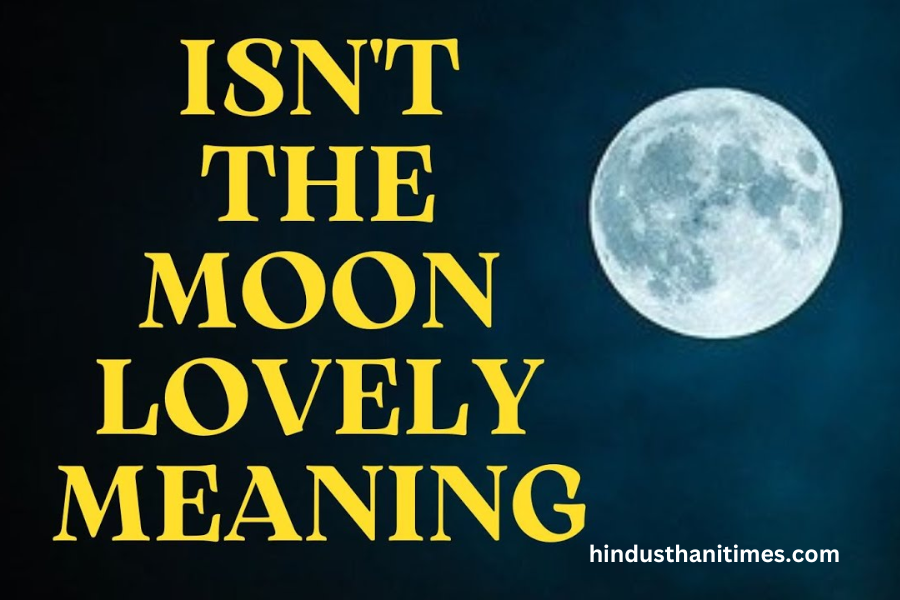The moon, with its enchanting glow and mesmerizing presence, has captivated humans for centuries. Its beauty and symbolism have been the inspiration for countless works of art, literature, and music. But beyond its aesthetic appeal, the moon holds a deeper meaning that resonates with people on a personal level. In this article, we will delve into the meaning behind the phrase “Isn’t the Moon Lovely” and explore the historical, cultural, and personal significance of this celestial body.
The Beauty and Symbolism of the Moon
The moon, with its luminous silver rays and ethereal glow, has long been admired for its beauty. Throughout history, poets and artists have been drawn to its enchanting presence, using it as a metaphor for love, mystery, and longing.
The moon’s serene and tranquil nature has inspired countless works of art, from Vincent van Gogh’s “Starry Night” to Claude Debussy’s “Clair de Lune.” Its symbolism transcends cultural boundaries, representing both the feminine energy and the cycles of life and death.
Exploring the Meaning Behind “Isn’t the Moon Lovely”
The phrase “Isn’t the Moon Lovely” invites us to reflect on the moon’s beauty and contemplate its deeper meaning. It encourages us to pause, look up at the night sky, and appreciate the celestial wonder that has been a constant companion throughout human history.
The moon serves as a reminder of the vastness of the universe and our place within it. It reminds us to connect with our surroundings, find solace in nature, and embrace the fleeting moments of beauty that exist in our everyday lives.
Historical and Cultural Significance of the Moon
The moon has played a significant role in various cultures and civilizations throughout history. In ancient times, the moon was often associated with deities and worshipped as a symbol of fertility, creation, and the divine feminine.
Many cultures also relied on the moon to track time, with lunar calendars guiding agricultural practices and religious ceremonies. The moon’s influence on tides and its connection to the menstrual cycle further solidified its association with the feminine energy.
Poetry and Literature Inspired by the Moon
From the haunting verses of William Shakespeare to the introspective prose of Virginia Woolf, the moon has inspired some of the most profound literary works in history. Poets have often used the moon as a metaphor for unrequited love, longing, and the passage of time.
In “Romeo and Juliet,” Shakespeare writes, “It is the east, and Juliet is the sun. Arise, fair sun, and kill the envious moon.” These words capture the moon’s symbolism as a rival to the sun’s radiance and a catalyst for forbidden love.
Art and Music Influenced by the Moon
Artists and musicians have drawn inspiration from the moon’s ethereal beauty, translating it into visual and auditory masterpieces. The Impressionist movement, with its emphasis on capturing light and atmosphere, often depicted moonlit scenes, evoking a sense of tranquility and mystery.
In music, composers have created haunting melodies and compositions that reflect the moon’s peaceful presence. Claude Debussy’s “Clair de Lune” is a prime example, with its delicate piano notes evoking the moon’s gentle glow.
Personal Interpretations of “Isn’t the Moon Lovely”
The phrase “Isn’t the Moon Lovely” invites personal interpretations and reflections on the moon’s meaning. For some, the moon represents a source of calm and tranquility in a chaotic world. Its serene presence serves as a reminder to slow down, appreciate the present moment, and find solace in nature.
Others may find inspiration in the moon’s cycles of waxing and waning, seeing it as a metaphor for the ups and downs of life. The moon’s ever-changing appearance can be a symbol of hope and a reminder that everything is transient.
Connecting with Nature Through the Moon
In our fast-paced, technology-driven world, it is easy to lose touch with the natural world around us. The moon provides an opportunity to reconnect with nature and experience a sense of wonder and awe.
Taking the time to observe the moon’s phases, from the delicate crescent to the radiant full moon, can be a grounding and meditative practice. It allows us to appreciate the beauty of the natural world and reminds us of our place within the vast cosmos.
Conclusion
In a world filled with distractions and noise, the moon serves as a reminder to pause, reflect, and appreciate the beauty that surrounds us. Its timeless presence and symbolic meaning have inspired countless works of art, literature, and music. “Isn’t the Moon Lovely” invites us to embrace the moon’s enchanting beauty and delve into its deeper significance. By connecting with the moon, we can find solace, inspiration, and a renewed sense of wonder in our everyday lives.



